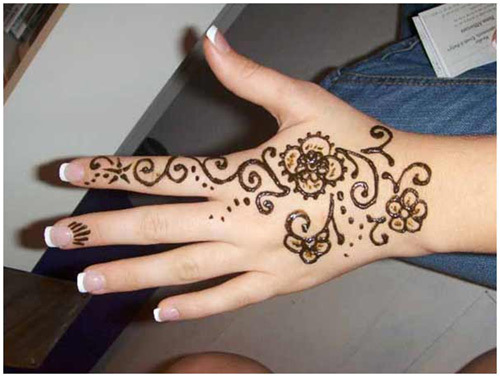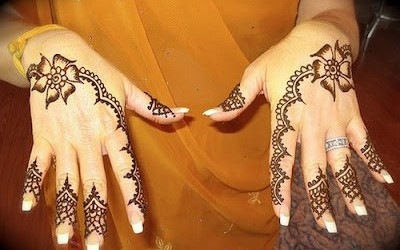Easy Mehndi Designs Definition
Source (Google.com.pk)Henna is used to create temporary tattoos mainly to the hands and feet of a woman. Traditionally it was used for its medicinal qualities. It became popular in India because of its cooling effect in the hot Indian summers. The two most popular uses of the henna is for dying hair and making tattoos on different parts of the body.
Let us start with the basic. Henna is made from herbs, meaning it is all natural. The powder is extracted from a henna plant, where the leaves are dried and grounded into a fine powder. This powder should be mixed with water, eucalyptus oil, tea, coffee, and lime and then applied on the body.
You may also hear the term 'Mehndi '. This is the Indian term for Henna, which is used to describe the art of applying henna onto your hands and feet.
People usually choose areas that are visible - the palm, arm, feet, wrist or around the navel. There are different designs and patterns that can be used to draw intricately on a woman's hand. During my wedding, we hired an artist who had various books containing different patterns. Our artist had an impromptu style but there are many templates you can use to apply your design. In order to get the color of mehndi to last a long time, read the 5 steps below.
Because it is a natural dye, the color is beautiful and gives the hair a lustrous look. The color ranges from black to red to brown. Henna has to be mixed in the right proportion with the right ingredients to get the desired color and effect. Henna works by coating the hair strands. It's been said that henna cannot lighten your hair, but, I'd have to disagree. My mom's hair is naturally dark brown, almost black and with the use of henna the color significantly lightens to a faint brown. Henna stops falling hair and itching of the scalp. It also helps dandruff problems.
The art form of henna or mehndi varies significantly from region to region. Varying designs have different meanings for members of each culture, such as good health, fertility, wisdom, protection and spiritual enlightenment. Various shades of Henna are procured by mixing its paste with the leaves and fruit of other plants, such as indigo, tea, coffee, cloves and lemon. When used in decorative body art, sugar and oil are also added to the mixture to strengthen the color and longevity of design.
Henna Designs For Palm
A full hand design, either palm or back with the help of henna paste looks always trendy.
Henna Designs For Palm
While Arabic henna designs are usually large, floral patterns on the hands, Indian mehndi involves fine, thin lines for lacy, floral and paisley patterns covering entire hand and also forearms. Most traditional henna patterns are based on very simple shapes - circles, triangles and lines are the most basic. These shapes can be combined to create a very intricate pattern and a very beautiful henna design on palm.
The various mehendi designs meant for hands include flower arches, henna web, flower net, flowery trails, lucky lotus, leaves chains etc. While decorating an entire hand, one can start where it is most comfortable, depending on the design. Common starting points are the line where the fingers bend bordering the palm, the wrist, or the center of the palm. It is usually easiest to begin by covering the palm, and then doing the fingers.Henna Designs For Feet
Henna Designs For FeetHenna designs done on the feet, involves painting beautiful and elaborate patterns with a dye made from crushed leaves of the henna plant. The Middle Eastern style consisted mostly of floral patterns inspired by Arabic carvings, paintings and textiles. This casual style did not usually follow a specific pattern. The North American style accentuated the shape of the feet using geometric floral patterns. The Indian and Pakistani designs are made up of intricate, repetitive paisley patterns, lines and teardrops.
Some of the popular designs for feet include flowers, leafy tendrils, and abstract shapes. Applying henna designs on feet are a little more difficult, but can be created easily with a bit of concentration. Usually, the sides or bottoms of the feet, are decorated with blocks of color on the tips of toes.
Easy Mehndi Designs for Hands Backhand for Feet Images for Back Hands 2013
Easy Mehndi Designs for Hands Backhand for Feet Images for Back Hands 2013
Easy Mehndi Designs for Hands Backhand for Feet Images for Back Hands 2013
Easy Mehndi Designs for Hands Backhand for Feet Images for Back Hands 2013
Easy Mehndi Designs for Hands Backhand for Feet Images for Back Hands 2013
Easy Mehndi Designs for Hands Backhand for Feet Images for Back Hands 2013
Easy Mehndi Designs for Hands Backhand for Feet Images for Back Hands 2013
Easy Mehndi Designs for Hands Backhand for Feet Images for Back Hands 2013
Easy Mehndi Designs for Hands Backhand for Feet Images for Back Hands 2013
Easy Mehndi Designs for Hands Backhand for Feet Images for Back Hands 2013
Easy Mehndi Designs for Hands Backhand for Feet Images for Back Hands 2013
.jpg)









No comments:
Post a Comment